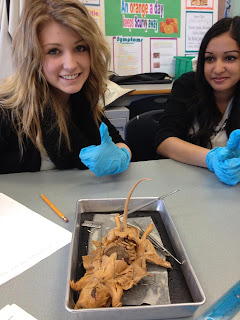Rat Dissection
I learned allot by dissecting this rat and i thought it was lots of fun. The Purpose of this dissection was to see first hand and really understand what everything is a looks like. After this dissection i really understand what everything is and the functions and uses for all the internal organs. Out of all of our dissections this term i think this one was my Favorited and i am looking forward to dissecting the pig next year !:)
I learned allot by dissecting this rat and i thought it was lots of fun. The Purpose of this dissection was to see first hand and really understand what everything is a looks like. After this dissection i really understand what everything is and the functions and uses for all the internal organs. Out of all of our dissections this term i think this one was my Favorited and i am looking forward to dissecting the pig next year !:)
Discussion question #1
1.Why are your hands the best tools in dessection?
It gives you more stability and accuracy when handleing the rat and gives you more control so you can go deep and not damage the organs.
2.What is the purpose of having all the different labels and titles for the dissection?
Helps us know which body part it is and for us to get a better understanding of what we are learning about.
The tail had scales on it and little hair, and the rest of the body is covered in hair.
4.What purpose is served by the vibrissae?
they are used for tactical sensation and contain no nerves inside them.
5.You specimen is bilaterally symmetrical. What does this mean?
This means if you were to cut it in half it would be exactingly the same on both sides.
Discussion question #2
1.The sphincter is described as a circular muscle. why is it this shape and what does it do ?
It is a circular muscle so that liquids are able to pass through, it regulates the passage of some fluids in the body like urine.
2.Why is there a difference in size between the small and large intestines?
The small intestine receives digestive food from the stomach and the width is smaller then the large intestine but the length is longer.
3.The liver is the largest organ in the body (after the integument) What are its function?
The liver in the rat has many different functions It produces essential enzymes for metabolizing nutrients, It is essential for filtering contaminants from the blood and converting waste into something they can dispose of. Vitamins and minerals are also stored in the liver.
The word "duodenum" comes from the latin word "duodenum digitorum" which means 12 fingers bredth.
5.What purpose is served by the appendix in those animals that retain it as a functional organ?
The purpose of the appendix is to protect your gut from germs and it produces good germs aswell.
Discussion questions #3
1. In each of the cavities, there is a membrane that covers both the wall of the cavity and the organ it contains. What is the function of the membrane?
2.What is the function of the spleen?
The spleen is associated with the circulatory system and the function is the destruction of the blood cells and blood storage.
3.What is the function of the diaphragm?
It is a large layer of muscle that separates the thoracic from the abdominal cavity.
The Atria is a chamber in the heart that receives incoming blood, the ventricle is a muscular chamber in the heart that pumps blood through the body.
5.Why is the wall of the left ventrical thicker than that of the right?
The left ventrical is thicker because it has to pump blood at all areas of the body where the right netrical only has to pump blood to the lungs which is a shorter distance.
6.What similarities exist between the male and the female reproductive system?
Two similarites of male and female reproductive system in a rat is their adrenal gland kidneys both are identical and connect to their bladders.
7.What do the kidneys do?
Kidneys excrete nitrogenous waste (urine) and also regulate the water balance
8.In the dissection, you located the thyroid, the thymus, and the adrenal glands. To which system do they belong and what do they do?
The thyroid gland belongs to the digestive system and they release hormones into the body (thyroxine and triiodothyronine) and regulates your body's metabolism It is located under your voice box. The Thymus gland belongs to the immune system and its function is it produces several hormones, called thymine, which stimulate the production and development of T cells. T cells play an important role in immunity. The adrenal glands are located on top of the kidney, its function is producing several hormones that affect blood pressure and blood sugar levels, growth, as well as some sexual characteristics.
The thyroid gland belongs to the digestive system and they release hormones into the body (thyroxine and triiodothyronine) and regulates your body's metabolism It is located under your voice box. The Thymus gland belongs to the immune system and its function is it produces several hormones, called thymine, which stimulate the production and development of T cells. T cells play an important role in immunity. The adrenal glands are located on top of the kidney, its function is producing several hormones that affect blood pressure and blood sugar levels, growth, as well as some sexual characteristics.










Great entry! Cute photo at the end! It was such a pleasure to teach you this semester Kenidee!!
ReplyDeletePurpose 4/4
Relate to class 4/4
Reflection 4/4
Writing 4/4
Photos 6/6
Questions 18/18
40/40